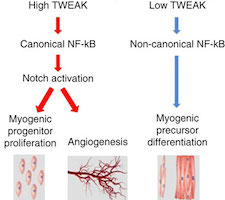A paper from cardiologist Aloke Finn and colleagues (published Wednesday, Aug. 5 in Nature Communications) describes how the protein CD163, produced by macrophages, puts the brakes on muscle repair after ischemic injury in mice. Here’s why we think this paper is interesting.
*Speculatively, there are connections to the recent wave of “young blood cures old body” parabiosis research. Increased CD163 is a marker of aging in humans. Maybe low levels of CD163 are part of how young blood is restorative.
*Translational potential — it wouldn’t be too hard to make an antibody against human CD163. Something that blocks CD163 could possibly be used to treat muscle breakdown, which occurs in response to injury, inactivity and in diseases such as cancer and diabetes.
*Finn says his team was surprised to find that mice lacking CD163, tested in experiments where blood flow is restricted in one leg, showed increased blood vessel and muscle growth in the other leg. It looks like part of CD163’s role is to limit muscle regeneration to the site of injury.
 *For molecular signaling aficionados, there’s a link between Notch signaling (important for regulating muscle growth and differentiation) and the inflammatory master regulator NFkB. While chronic inflammation is bad for muscle growth, here an inflammatory signal from the cytokine TWEAK is good.
*For molecular signaling aficionados, there’s a link between Notch signaling (important for regulating muscle growth and differentiation) and the inflammatory master regulator NFkB. While chronic inflammation is bad for muscle growth, here an inflammatory signal from the cytokine TWEAK is good.
*The paper revises existing ideas about how TWEAK affects muscle growth and differentiation. TWEAK has also been shown to be connected to liver regeneration and stroke (that last one is from Emory’s own Manuel Yepes).

